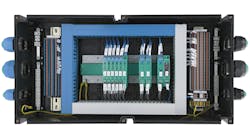Obsolescence of components and equipment is a continual challenge facing a variety of industries. It’s important for companies to minimize the inherent risks produced by obsolete components by realizing its causations, understanding the impacts and constructing reliable solutions.
Drivers of component obsolescence
There are several primary factors that drive component obsolescence. The first is technological evolution, which can render older technologies less practical and competitive. Moore’s Law predicts that the number of transistors, and thus processing power, within computer chips will double every two years, and this has been proven true every year since Intel was founded in 1968. The exponential rate of technological growth creates technical obsolescence in the industrial sector at an increasing velocity, reducing many of the competitive lifecycles for components. These increasingly shorter lifecycles mean that components are becoming obsolete faster than ever before.
Environmental policies and legislation can also produce component obsolescence. The Restriction of Hazardous Substances (RoHS) Directive 2002/95/EC (www.controldesign.com/rohs), restrict the use of materials used in various types of electronic and electrical equipment, including printed circuit boards. The European Ecodesign Directive and the Energy Independence and Security Act additionally require certain energy-efficiency levels to be met for industrial motors. For many component manufacturers, this type of regulation means product lines have to be redesigned or upgraded to meet these new standards.
Lastly, planned product obsolescence by manufacturers of components can drive obsolescence. This is a strategy in which obsolescence of a product is built into the product from its conception. Products are designed with an artificially bound functional life. Many component and equipment manufacturers decide to pursue this strategy for a number of reasons. However, it is primarily because they’d rather allocate their resources to researching and developing newer technologies than producing outmoded parts. This is an increasing trend today, as end-of-life documents produced by manufacturers announcing their components as obsolete increase year over year by as much as 25%.
Consequences of component obsolescence
Component obsolescence produces a broad range of consequences across many industries. The primary fear for many industrial managers is the loss of equipment capability (downtime). Having a legacy or obsolete part go down without a reliable source for spares can be a terrible ordeal. A 2006 Advanced Technology Services survey of 101 manufacturing executives in the automotive industry conducted by Nielsen Research revealed that one minute of downtime can cost a company in that sector an average of $22,000. Failing to meet production schedules can also severely damage credibility with a plant’s end customers.
Obsolescence can also impact design. Some design cycles are long enough that a major portion of the components are obsolete prior to the system being fielded. Re-engineering obsolete systems is often not a viable solution because of the high costs. In highly regulated industries, such as nuclear and pharmaceuticals, there can be significant paperwork and red tape in upgrading all or part of a system. Redesigning and requalifying processes can be major expenses for many companies.
Obsolescence additionally increases through-life support costs. When part manufacturers notify their customers of a component being discontinued, users are usually given a final buy opportunity. Users must then strategically estimate their current and future demand for that particular equipment. This can often be a challenge, as forecasting demand of a component depends on a number of variables. These can include production and sales forecasts, as well as sustainment expectations and failure rates. Because this demand can be difficult to predict, purchasing too few or too many spare components can increase costs and inefficiencies for companies.
Solutions to component obsolescence
Designing with obsolescence in mind can resolve many issues. Design engineers can choose products with longer predictable lifecycles in order to preemptively mitigate risk. While there will always be aspects of design that continue to hold obsolescence risks, it is helpful if companies review these risks and find them tolerable during the decision-making process. Early identification of risks is key for providing a wide range of solutions and reducing the costs of obsolescence. Many companies are now employing obsolescence managers or teams. By planning with design teams and conducting risk analysis, managers can maintain obsolete systems for lengthy time periods while staying within national standards.
Companies can also reduce risks by having a stable repair and preventive maintenance program in place. Conducting frequent maintenance actions increases system reliability and availability over the long run. Companies can pursue several possible replacement and repair strategies: either corrective, where components are replaced and/or repaired only at failure; or preventive, where components are replaced at optimal intervals before failure. Managers can take steps to find the optimal maintenance intervals for components by using a variety of mathematical models. Companies can also execute a mixture of both of these strategies. Although investing in repairs and preventive maintenance increases total system costs, reducing repair and maintenance allocations can lead to downtime and large production losses.
Finding a reliable independent distributor who can source obsolete components can further help to mitigate obsolescence risks. Usually these distributors can offer like-for-like replacements and repairs for parts no longer carried or supported by the manufacturer. Replacing failed components is usually cheaper and quicker than upgrading a whole system. Replacement helps to resolve problems faced by regulated industries, is the quickest method of reducing downtime and can improve the inefficiencies presented by through-life support costs. Companies should take the time to find a trustworthy distributor who stocks the obsolete components prior to equipment failing or spares being needed. Having an alternate supply chain and qualified independent distributor already in place to solve and avert disruptions is crucial to reducing much of the risk associated with obsolescence.
ALSO READ: What to do when it's time to update legacy technology
Conclusion
Obsolescence will remain a key risk for many companies in the years to come. Most engineers and users would love to be continually upgrading their systems to the newest and best technologies. This option is not economically viable for many companies. Despite its connotations, “obsolete” does not mean entirely useless. Many older components, including a diverse amount from the 1980s and 1990s, are still reliable, competent and in place today. A well-designed, managed and maintained system with alternate supply-chain options can operate for many years efficiently and productively with reduced downtime.




